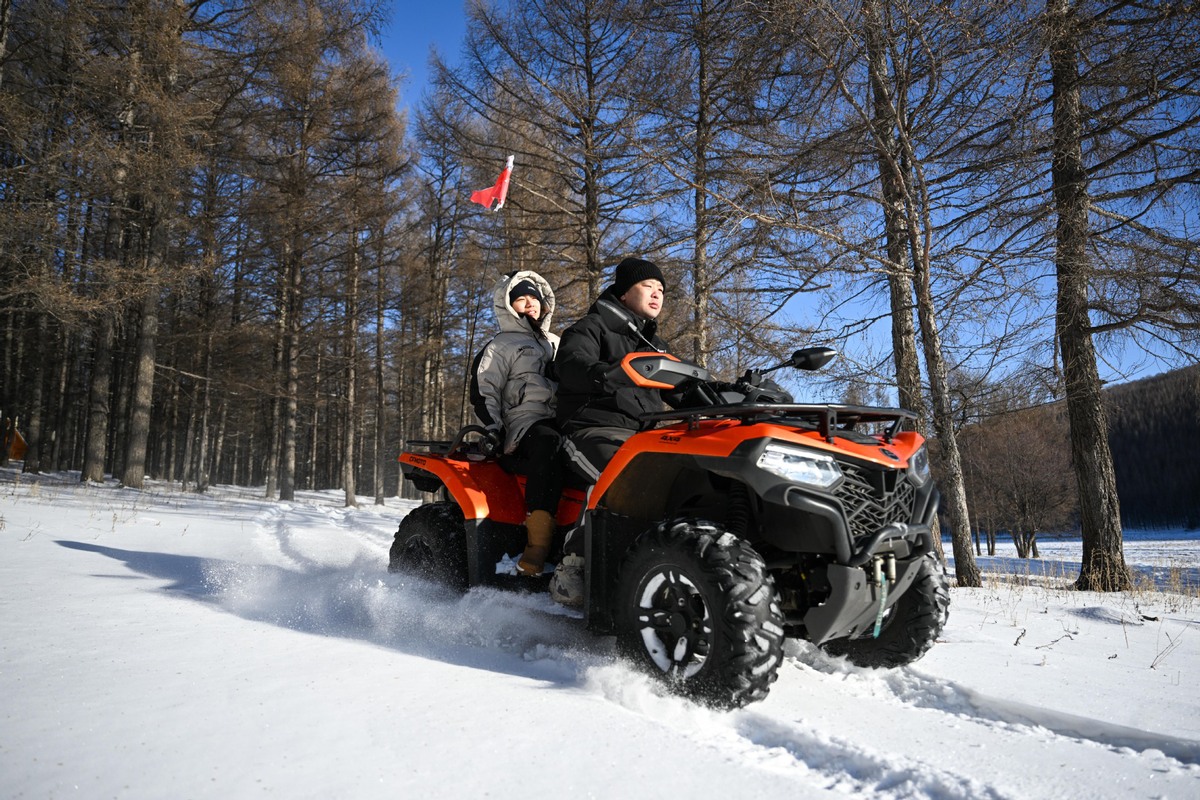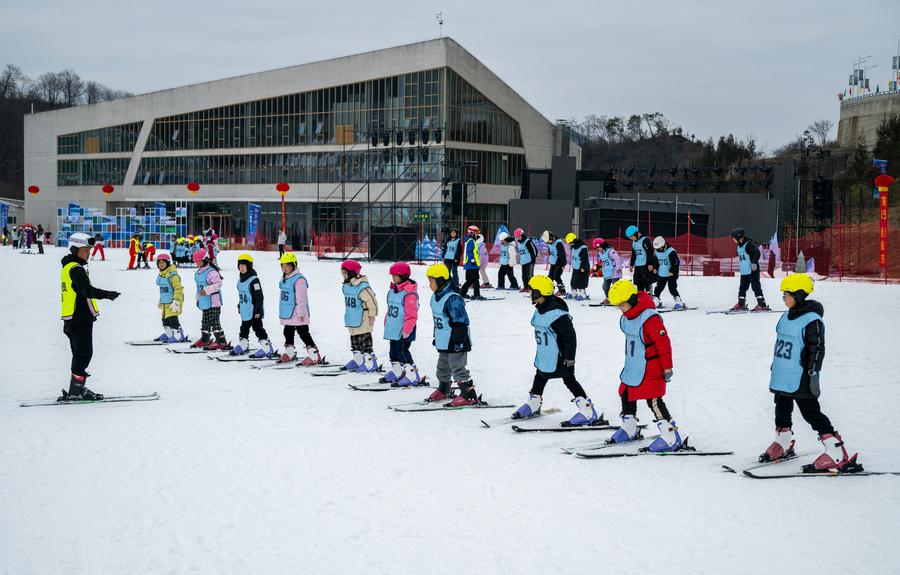How China’s “Frozen Assets” Are Fueling Its Growth Engine

The ice and industry is seeing rapid development, marked by an expanding market size, increasingly diverse consumer demand, a more dynamic supply chain and active exports of ice and snow equipment.
On the first day of the New Year, a forest ranch in the city of Arxan in north China’s Inner Mongolia Autonomous Region hosted a new and unique event—the Ice and Snow Naadam. Naadam is a traditional Mongolian festival celebrating harvests and prosperity, held typically in summer, featuring traditional sports such as wrestling, horse racing and archery.
The Ice and Snow Naadam merged traditional elements of Naadam with the thrill of winter sports, including the majestic sight of horses charging through the snow and the fierce intensity of snow wrestling. The festival not only pays tribute to the time-honored Mongolian festival but also highlights the region’s deep cultural roots, giving visitors an unforgettable taste of its distinctive ice and snow culture.
“The Ice and Snow Naadam, as a flagship event of this winter tourism season, integrates sport, ice and snow elements, and tourism, offering visitors a chance to fully experience its unique charm,” said Bai Feng, Deputy Mayor of Arxan. “With its high-quality snow and exceptional natural beauty, the Arxan region continues to enrich its winter tourism offerings, driving the growth of its ice and snow economy.”
The ice and snow economy refers to social, economic and cultural activities related to ice and snow, which are driven by the development and utilization of the country’s “cold” resources, generating both social and economic benefits. It spans a broad range of sectors, including ice and snow sport, tourism, culture, education and equipment, making it a vast industry with an extensive supply chain.
A report on China’s ice and snow industry released in 2024 at the World Winter Sports (Beijing) Expo read that the sector has grown rapidly, expanding from a scale of 270 billion yuan ($36 billion) in 2015 to 970 billion yuan ($132 billion) in 2024. It is projected to surpass the trillion-yuan ($136-billion) mark in 2025.
This indicates that the industry is seeing rapid development, marked by an expanding market size, increasingly diverse consumer demand, a more dynamic supply chain and active exports of ice and snow equipment, said the report.
Winter wonderland
Beyond the pulsating cultural buzz of events like the Ice and Snow Naadam, Arxan’s distinctive geography and climate deliver breathtaking winter scenery—offering travelers additional reasons to visit.
In the midst of Arxan’s vast forest, blanketed in frost, the air is often filled with the delighted gasps of visitors. One of the area’s most captivating features is a river that never freezes. Kayaking along its winding path, travelers are surrounded by the magic of the frozen forest.

This winter, ice and snow are being merged with hot springs, educational tours, sport, intangible cultural heritage, gourmet food and festive traditions. Arxan is using its icy resources to create seemingly endless possibilities for the enrichment of its winter tourism experience. On the past New Year’s Eve and New Year’s Day, Arxan hosted 18,600 visitors, generating a record-breaking tourism revenue of 23 million yuan ($3.1 million).
“The ice and snow economy is a trillion-yuan (over $100-billion) industry, giving rise to an expanding array of new experiences. It spans multiple sectors, including food and beverage, accommodation, transportation, tourism, shopping and entertainment,” Han Yuanjun, an associate researcher at the China Tourism Research Institute, told Beijing Review.
He said that the key to advancing the ice and snow economy is to continuously expand and solidify the participant base. Regions rich in ice and snow resources should focus on integrating those resources and prioritizing the development of mass-participation ice and snow activities, rather than solely investing in ski-specific projects.
It is essential to extend the industry chain, creating new business models and new consumption scenarios, such as leveraging technologies to build unique ice and snow environments or boosting the development of local ice and snow brands.
To seize opportunities, stay ahead of the curve and capitalize on growing demand, industry stakeholders in places like Arxan are constantly innovating.
In northeast China, the Harbin Ice and Snow World, part of the world’s largest ice and snow festival, in the capital city of Heilongjiang Province, visitors are awed by the stunning ice sculptures of the Terracotta Warriors and the Frozen Yellow Roses inspired by the popular TV drama The Tale of Rose. In Jilin Province, tourists can explore the “snow street,” a vibrant market featuring local cultural products and agricultural produce, while also enjoying traditional Chinese wellness treatments at the snow resorts. While on the frozen Taizi River in Liaoning Province, visitors can enjoy activities ranging from soothing massages, traditional Chinese medicinal cupping sessions and sipping warm ginseng tea to ice fishing and crafting ice lanterns on the frozen river surface.
In Fuyuan, Heilongjiang, a skating marathon attracted over 2,000 enthusiasts from across the country. Meanwhile, in Xilin Gol, Inner Mongolia, a grand self-driving ice and snow adventure race kicked off, drawing over 10,000 spectators.
These events not only thrill participants but also prove their economic value. For instance, the 14th National Winter Games, which took place in Inner Mongolia in February 2024, generated 32 billion yuan ($4.4 billion) in sports-related consumption.
The ice and snow equipment industry is also experiencing a boom. China has developed a comprehensive ecosystem for ice and snow gear, spanning 15 distinct categories. As a result, the number of companies in this space continues to rise, and sales have surged from just under 5 billion yuan ($682 million) in 2015 to 22 billion yuan ($3 billion) in 2023.

What’s even more fascinating is the rise of niche products, like outdoor jackets, which have evolved from specialized gear to stylish urban essentials. These now hold strong appeal among the younger generation. In fact, Sanmen County in Taizhou, Zhejiang Province, alone is home to more than 300 outdoor jacket manufacturers, with an annual production value surpassing 2 billion yuan ($273 million).
New measures to stimulate ice and snow consumption are constantly emerging. Airlines have launched ice and snow-themed routes, while some local governments are distributing ice and snow consumption vouchers to boost related spending.
Beyond seasonal boundaries
Ice and snow sports are highly sensitive to temperature and humidity, and are constrained by seasonal and regional limitations. Few southern regions receive substantial ice and snow. However, from a consumer psychology perspective, the scarcity of such resources in these regions actually fuels a stronger desire for ice and snow-related experiences.
“Compared to the north, ice and snow tourism in the south is more oriented toward leisure and relaxation, with snow parks and ice resort towns creating a rich, playful atmosphere,” Han said.
In Anhui Province, visitors can admire the snow-capped beauty of Huangshan Mountain and experience the unique charm of the gentle and subtle Anhui culture, while in Sichuan Province, the rolling clouds of Xiling Snow Mountain offer breathtaking views, complemented by cozy tea ceremonies and rejuvenating hot spring wellness.
Han pointed out that nowadays, while traditional ice and snow tourism destinations are seeing the majority of their visitors come from the south, southerners’ enthusiasm also stimulates the development of their local ice and snow industries.
Taking an indoor ski resort in Wuxi in east China’s Jiangsu Province, as an example, the facility has recently been attracting hundreds of skiing enthusiasts every day, with 70 percent of them coming from the Yangtze River Delta region. For many urban dwellers accustomed to mild winters, such facilities have redefined the winter experience.
According to a report on mass ice and snow consumption released by the General Administration of Sport of China, the number of indoor ski resorts in China increased from just five during the 2013-14 snow season, typically running from November to March, to 59 by the 2023-24 season, with the majority of these resorts located in southern cities.
Han said the realization of snow play in southern regions is supported by two key factors. First, with continuous progress in refrigeration technology, a range of cutting-edge snowmaking and snow track design technologies have made it possible for indoor ski resorts to operate largely unaffected by seasonal changes or weather conditions.

Second, southern cities boast a large consumer base, characterized by a huge population and strong purchasing power. These regions also benefit from extensive experience and resources in commercial operations and technological innovation. As they embrace the ice and snow economy, they inject fresh development ideas and competitive energy into the industry.
As the ice and snow craze becomes a new winter culture, southern cities are actively making strategic moves. For example, Guangzhou in Guangdong Province has supported the development of the ice and snow industry through tax reductions for related enterprises, while Shenzhen, also in Guangdong, hosted the first Chinese Men’s Professional Ice Hockey League and built the largest indoor ski resort in the Guangdong-Hong Kong-Macao Greater Bay Area.
In the summer, indoor ice and snow facilities in southern China not only serve as a cool escape from the heat but also become a key attraction that drives nearby offline commercial activity.
Winter beyond borders
On January 4, the three-day Harbin International Ice and Snow Sculpture Festival came to a close. Thirty ice sculpture teams from 12 countries, including China, Ecuador, Spain and Russia, competed side by side, exchanging artistic ideas and deepening cultural understanding in the process.
The ninth Asian Winter Games is set to kick off on February 7 in Harbin, Heilongjiang, with many international guests joining in to experience the city’s lively ice and snow culture.
With the successful hosting of the 2022 Beijing Winter Olympic and Paralympic Games, and the upcoming Asian Winter Games in Harbin, China’s ice and snow economy is poised for further internationalization. “This will attract more international participants to join in the development of China’s ice and snow industry, fostering the emergence of ice and snow culture and tourism brands with global influence,” Han said.
It’s crucial to enhance the international competitiveness of ice and snow-related industries, such as exporting equipment, promoting inbound tourism and internationalizing winter sports events. These efforts will drive the high-quality development of the ice and snow economy, he added.
 Facebook
Facebook
 Twitter
Twitter
 Linkedin
Linkedin
 Google +
Google +










